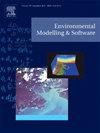基于混合元胞自动机的交通场景微模拟空气污染模型
IF 4.8
2区 环境科学与生态学
Q1 COMPUTER SCIENCE, INTERDISCIPLINARY APPLICATIONS
引用次数: 0
摘要
在预测未来干预影响时,情景微模拟(如基于主体的模型)可以考虑反馈、时空和社会异质性。解决空气污染暴露问题需要交通情景模型(即无车区)。传统的空气污染模型不能满足交通场景微观模拟的所有要求:隔离交通排放,整合相关弥散调节因子,同时计算效率高,互操作性强,有效。我们提出了一个基于土地利用回归的基线浓度和道路排放的混合模型,并结合基于元胞自动机的越野分散。该模型有效地评估了空气污染,同时考虑了气象和形态扩散过程。我们使用遗传算法进行校准,并根据阿姆斯特丹各地NO2浓度的移动测量和固定站点常规监测数据对模型进行外部验证。我们的模型在50 m × 50 m栅格中实现了0.60的外部验证R2和0.48 s的计算时间。此外,我们成功预测了第一个Covid-19封锁交通情景的二氧化氮减少(R2 0.57)。本文章由计算机程序翻译,如有差异,请以英文原文为准。

Hybrid cellular automata-based air pollution model for traffic scenario microsimulations
Scenario microsimulations like agent-based models can account for feedbacks and spatio-temporal and social heterogeneity when projecting future intervention impacts. Addressing air pollution exposure requires traffic scenario models (i.e. of car-free zones). Traditional air pollution models do not meet all requirements for traffic scenario microsimulation: isolating traffic emission, integrating relevant dispersion moderators, while computationally efficient, interoperable and valid. We propose a hybrid model of land use regression-based baseline concentrations and on-road emissions in conjunction with cellular automata-based off-road dispersion. The model efficiently assesses air pollution, while accounting for meteorological and morphological dispersion processes. We calibrate using genetic algorithms and externally validate the model based on mobile measurements and fixed-site routine monitoring data of NO2 concentrations across Amsterdam. Our model achieves an external validation R2 of 0.60 and 0.48 s computation time in a 50 m × 50 m raster. Further, we successfully projected the NO2 reduction of the first Covid-19 lockdown traffic scenario (R2 0.57).
求助全文
通过发布文献求助,成功后即可免费获取论文全文。
去求助
来源期刊

Environmental Modelling & Software
工程技术-工程:环境
CiteScore
9.30
自引率
8.20%
发文量
241
审稿时长
60 days
期刊介绍:
Environmental Modelling & Software publishes contributions, in the form of research articles, reviews and short communications, on recent advances in environmental modelling and/or software. The aim is to improve our capacity to represent, understand, predict or manage the behaviour of environmental systems at all practical scales, and to communicate those improvements to a wide scientific and professional audience.
 求助内容:
求助内容: 应助结果提醒方式:
应助结果提醒方式:


